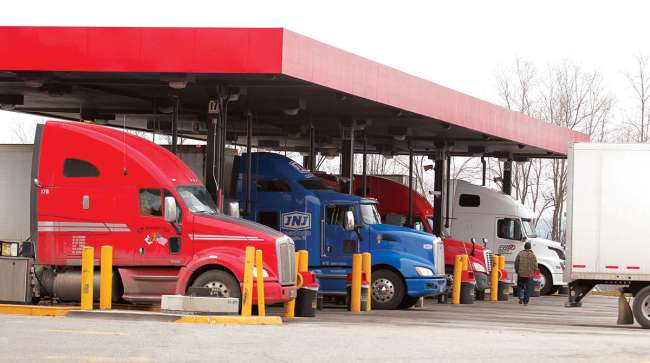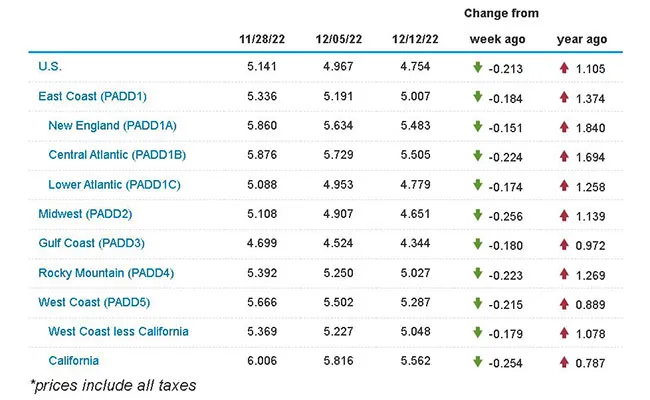Senior Reporter
Diesel Plunges 21.3¢ to $4.754 a Gallon

[Stay on top of transportation news: Get TTNews in your inbox.]
The national average price of diesel continued its downward trajectory, falling 21.3 cents to $4.754 a gallon, according to Energy Information Administration data released Dec. 12.
Diesel has shed 38.7 cents a gallon in just the past two weeks and 58.7 cents since Oct. 24.
Trucking’s main fuel is at its lowest cost since it was $4.104 on Feb. 28. On average, diesel now costs $1.105 more for a gallon than it did at this time in 2021.
The average cost for a gallon fell in all 10 regions in EIA’s weekly survey. The greatest decline was 25.6 cents in the Midwest, and the smallest was 15.1 cents in New England.
U.S. On-Highway Diesel Fuel Prices

EIA.gov
Gasoline is now cheaper than a year ago, as a 15.1-cent drop to a national average of $3.239 a gallon leaves it 7.6 cents lower.
Chicago-based oil industry analyst Phil Flynn told Transport Topics that U.S. refineries have been running at nearly 95% capacity the past several weeks, and that is one reason why prices have declined as more product is in the market and demand for gasoline usually drops during the winter months.
U.S. average retail prices for December 12, 2022:
Regular grade #gasoline: $3.24/gal
On-highway #diesel: $4.75/gal#gasprices https://t.co/dsfxiPA8Wj — EIA (@EIAgov) December 13, 2022
“Part of what we see at the end of the year, we’ve seen it in past years, the market has a big sell-off,” Flynn said. “If you remember last year at this time, we hit the low for the year, and then we went up to $120 a barrel for oil, and products went through the roof. I am kind of seeing the same cycle. We don’t want to get overconfident in December and then have the market turn up.”

Flynn
But Flynn said he is concerned that as colder weather moves into the Midwest and East in the coming weeks, demand for home heating oil will spike. That could tighten supplies, especially as home heating oil and diesel fuel essentially are the same product.
“The refiners are going full out to build up their inventories, and they’ve done an incredible job bringing it back, especially when it comes to diesel, and they’ve really turned it around. But can refineries run at full capacity all year long, the answer is no,” he added. “We haven’t had a very cold winter for several years, and when it’s not cold you tend to get complacent. If we get into a period of 15, 20 degrees below normal and if it’s a one-time thing, we’ll survive it. But if it becomes a pattern, where we are well below demand, we’ll be really challenged to keep prices stable.”

Kloza
Tom Kloza, founder of the Oil Price Information Service recently told TT that he believes fuel prices could keep declining in March as demand softens and supply increases.
Meanwhile, a new report from the Department of Energy shows the way in which oil and natural gas is being drilled is substantially changing.
In 2021, 81% of U.S. completed wells were drilled horizontally or directionally, as opposed to 19% of those wells that were drilled vertically.
The Energy Information Report said horizontal or directional drilling involves starting the well vertically and then, at a certain depth, bending the path of the drill at an angle.

Host Michael Freeze relays the story of a cybersecurity crisis at a transportation and supply chain management company and discusses strategies to avoid cyberattacks with a 30-year veteran of automotive cybersecurity systems. Hear a snippet, above, and get the full program by going to RoadSigns.TTNews.com.
“Although the total number of crude oil and natural gas wells completed in the United States declined by 66% between 2010 and 2021, and total footage or drilling length has fallen by 30%, U.S. crude oil production has more than doubled, and U.S. gross withdrawals of natural gas have increased 55%,” the report said.
“As horizontal and directional wells have become more common in the United States, the average footage of wells drilled has more than doubled from 7,300 feet per well to 15,200 feet per well between 2010 and 2021. Horizontal and directional wells are longer than vertical wells, allowing them to access more geologic formations that contain crude oil and natural gas, which increases those wells’ productivity,” the report also said.
The most recent Baker Hughes Rig Count shows that for the week ending Dec. 10, 780 rigs were in operation in the U.S. compared with 576 a year ago.
Want more news? Listen to today's daily briefing below or go here for more info:




